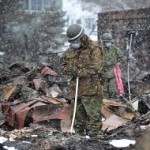 “HARTFORD, CT, November 16, 2011 – The devastation from the magnitude 8.9 earthquake that struck northeastern Japan in March of this year is almost unimaginable, with tens of thousands of people having fled, leaving the poor and the elderly to fend for themselves and gigantic piles of debris everywhere. That was the bleak picture painted by Jeffrey Bayliss, associate professor of history and an expert on Japan and Japanese culture and history, and Amelia Wei ’12, who spent a month in Japan during the summer conducting research concerning the recovery and relief efforts. Bayliss and Wei spoke at a November 15 Common Hour event sponsored by the Center for Urban and Global Studies.
“HARTFORD, CT, November 16, 2011 – The devastation from the magnitude 8.9 earthquake that struck northeastern Japan in March of this year is almost unimaginable, with tens of thousands of people having fled, leaving the poor and the elderly to fend for themselves and gigantic piles of debris everywhere. That was the bleak picture painted by Jeffrey Bayliss, associate professor of history and an expert on Japan and Japanese culture and history, and Amelia Wei ’12, who spent a month in Japan during the summer conducting research concerning the recovery and relief efforts. Bayliss and Wei spoke at a November 15 Common Hour event sponsored by the Center for Urban and Global Studies.
Like Wei, Bayliss traveled to Japan last summer, spending the majority of his time in the region where the earthquake and tsunami struck. The epicenter of the earthquake, the most powerful to hit Japan and one of the five most powerful in the world since record-keeping began in 1900, was roughly 40 miles east of the Oshika Peninsula of Tohoku. It triggered tsunami waves up to 133 feet high that traveled 10 miles inland and nuclear accidents at the Fukushima Nuclear Power Plant complex.
According to unofficial tallies, 15,836 people died; 3,650 are missing and presumed dead; 92,000 remain permanently displaced; 106,461 people are jobless; 91,484 buildings were completely destroyed; 40,454 were damaged beyond repair; and 265,149 were partially damaged. Altogether, there was 22 million metric tons of debris and the estimated cost of reconstruction is roughly $300 billion. In Ishinomaki, one of the cities that Bayliss visited, the piles of debris were four stories high.
“It looked like a war zone,” he said. “Five- and six-story buildings were knocked over like they were playthings.” Bayliss said most of the destruction stemmed from the tsunami waves and not from the earthquake itself, a testament to Japan’s strict building standards. Bayliss described what he saw as “apocalyptic scenes,” adding the tsunami “destroyed everything in its path.”
Bayliss began his talk by chastising the American news media for largely ignoring the aftermath of the catastrophe. Most Americans now think that either the areas destroyed by the earthquake and tsunami have been rebuilt or they’re now a nuclear wasteland. “Neither is accurate,” he said.
At the nuclear power plant, three reactors were operating at the time of the disaster. All suffered a partial or complete meltdown, Bayliss said, releasing radioactive isotopes such as iodine 131 and cesium 134 and 137. Thirteen municipalities had to be evacuated.
At that point in the presentation, Wei described what she found when investigating the relief and recovery efforts by Red Cross Japan, which has 200 staff members in Tokyo. The agency’s A Team was dispatched to the devastated areas and the B team trekked back and forth. The relief efforts “were really slow and it took a lot of time to make decisions,” said Wei, a political science major. “There were no clear procedures. Every decision was based on limited information.” Although people all over the world donated money for the recovery, the contributions had to be funneled through the Japanese government, which then doled them out, resulting in a very inefficient system.
Although donations surged after the catastrophic event and millions of Japanese volunteered their time and services in the wake of the earthquake and tsunami, today “the attention and awareness has died down,” Wei said. “The volunteer groups have no interaction with each other and it all seems very disorganized.”
With the reconstruction efforts having stalled, Bayliss said the future doesn’t look bright. The slow pace of the recovery can be attributed largely to the fact that the debris is just sitting there because some of it may be radioactive and no one wants it in their backyard. “We don’t have evidence of what happens to people who are exposed to low doses [of radiation] over the long term,” he said. Others are in “legal limbo” and don’t know whether to rebuilt or not.”
This article was originally published